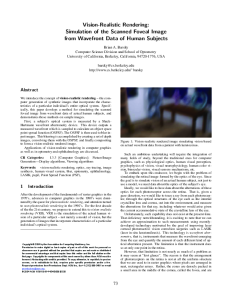Vision-Realistic Rendering: Simulation of the Scanned Foveal Image from Wavefront Data of Human Subjects
Abstract
We introduce the concept of vision-realistic rendering – the com- puter generation of synthetic images that incorporate the charac- teristics of a particular individual’s entire optical system. Specif- ically, this paper develops a method for simulating the scanned foveal image from wavefront data of actual human subjects, and demonstrates those methods on sample images. First, a subject’s optical system is measured by a Shack- Hartmann wavefront aberrometry device. This device outputs a measured wavefront which is sampled to calculate an object space point spread function (OSPSF). The OSPSF is then used to blur in- put images. This blurring is accomplished by creating a set of depth images, convolving them with the OSPSF, and finally compositing to form a vision-realistic rendered image. Applications of vision-realistic rendering in computer graphics as well as in optometry and ophthalmology are discussed.
Citation
Brian A. Barsky. "Vision-Realistic Rendering: Simulation of the Scanned Foveal Image from Wavefront Data of Human Subjects". Applied Perception in Graphics and Visualization, 2004.









